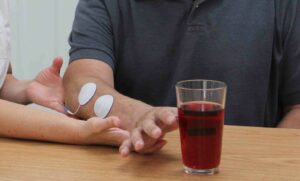Why Therapists Aren’t Utilizing Biofeedback as Often as They Should
NeuroRehab Team
Wednesday, August 28th, 2024
Introduction
Biofeedback is a powerful therapeutic technique that provides patients with real-time information about their physiological processes, empowering them to actively monitor and regulate their own bodily functions. Yet, despite its proven benefits, biofeedback remains significantly underutilized in the therapy world. In this comprehensive article, we’ll explore the reasons behind this underutilization and uncover the compelling advantages that make biofeedback a must-have tool in every therapist’s arsenal.
The Mechanics of Biofeedback
At its core, biofeedback involves the use of specialized equipment to measure and display various physiological signals, such as muscle tension, brain activity, heart rate, and skin temperature. By providing patients with immediate, visual or auditory feedback on these internal processes, biofeedback enables them to consciously control and modify their bodily responses. This real-time information allows patients to gain a deeper understanding of their own physiological states and develop effective self-regulation strategies.
The Proven Benefits of Biofeedback
The research on the efficacy of biofeedback is extensive and compelling. Numerous studies have demonstrated its ability to:
- Improve Postural Control and Balance: Biofeedback can help patients with neurological conditions or physical impairments to enhance their postural stability and balance, reducing the risk of falls and improving overall mobility.
- Enhance Strength and Range of Motion: By providing feedback on muscle activity, biofeedback can guide patients in developing better muscle control, leading to increased strength and improved range of motion.
- Reduce Spasticity and Spasms: Biofeedback has been shown to be effective in managing spasticity and involuntary muscle spasms, a common challenge for individuals with neurological disorders.
- Minimize Compensatory Movements: By highlighting areas of weakness or overcompensation, biofeedback can help patients identify and correct unhealthy movement patterns, promoting more efficient and natural movement.
- Activate Force Couples: Biofeedback can be used to target and activate specific muscle groups that work together as “force couples,” improving overall motor control and coordination.
- Improve Motor Control: The real-time feedback provided by biofeedback allows patients to refine their motor skills, leading to enhanced control and precision in their movements.
- Break Up Synergies: Biofeedback can help patients overcome the challenge of “synergies,” where multiple muscles are activated together, by enabling them to isolate and control individual muscle groups.
These are just a few of the many benefits that make biofeedback a valuable tool for therapists working with a wide range of patient populations, from stroke survivors to individuals with musculoskeletal disorders.
The Underutilization of Biofeedback in Therapy
Despite the substantial evidence supporting the efficacy of biofeedback, it remains significantly underutilized in the therapy world. Several factors contribute to this phenomenon:
- Lack of Awareness: Many therapists may not be fully aware of the capabilities and applications of biofeedback, limiting its adoption within their practices.
- Perceived Complexity: The technical nature of biofeedback equipment and the need for specialized training can create a perception of complexity, deterring some therapists from incorporating it into their treatment approaches.
- Reimbursement Challenges: Depending on the healthcare system and insurance coverage, the costs associated with biofeedback equipment and specialized training may not be adequately reimbursed, making it a less appealing investment for some practitioners.
- Time Constraints: In today’s fast-paced healthcare environment, therapists may feel pressed for time, and the additional setup and patient education required for biofeedback may be seen as a barrier to its widespread implementation.
- Resistance to Change: Some therapists may be hesitant to adopt new technologies or techniques, preferring to stick to familiar methods, even if biofeedback could potentially offer superior outcomes for their patients.
Overcoming the Barriers to Biofeedback Adoption
To address the underutilization of biofeedback in the therapy world, several strategies can be employed:
- Increased Education and Awareness: Continuing education programs, professional development workshops, and industry publications can help therapists gain a deeper understanding of the benefits and applications of biofeedback, dispelling misconceptions and promoting its adoption.
- Streamlined Training and Implementation: Manufacturers and biofeedback experts should work to develop more user-friendly equipment and provide comprehensive training programs to ease the technical barriers for therapists.
- Advocacy for Reimbursement: Healthcare organizations and professional associations can advocate for improved reimbursement policies that recognize the value of biofeedback and make it a more financially viable option for therapists.
- Demonstrating Tangible Outcomes: By consistently documenting and sharing the positive outcomes achieved through biofeedback, therapists can build a compelling case for its widespread adoption, highlighting the tangible benefits for both patients and practitioners.
- Fostering a Culture of Innovation: Therapy practices should cultivate an environment that encourages the exploration and integration of new technologies, such as biofeedback, to stay at the forefront of evidence-based, patient-centered care.
The Future of Biofeedback in Therapy
As the healthcare landscape continues to evolve, the role of biofeedback in therapy is poised to grow. Advancements in technology, such as the integration of wearable sensors and mobile applications, are making biofeedback more accessible and user-friendly. Click here to see some of the latest advances in Biofeedback that is currently commercially available. Additionally, the increasing emphasis on personalized, data-driven healthcare is likely to drive greater adoption of biofeedback as a valuable tool for tailoring interventions and monitoring patient progress.
By embracing biofeedback and overcoming the barriers to its implementation, therapists can unlock a powerful set of capabilities that can transform the way they approach patient care. From enhancing physical rehabilitation to supporting mental health and wellness, biofeedback has the potential to revolutionize the therapy field, leading to better outcomes, improved patient engagement, and more efficient, holistic care.
Conclusion
Biofeedback is a powerful therapeutic technique that has been consistently shown to deliver significant benefits for patients across a wide range of conditions. Yet, its underutilization in the therapy world remains a puzzling reality. By addressing the factors that contribute to this underutilization and fostering a culture of innovation, therapists can unlock the full potential of biofeedback and elevate the standard of care they provide. As the healthcare landscape continues to evolve, the integration of biofeedback into therapy practices will become increasingly crucial, paving the way for more personalized, data-driven, and effective patient outcomes.
Free Neuro Balance CEU Course Now Available
NeuroRehab Team
Thursday, May 11th, 2023
Improving Dynamic Balance Following Neurological Injury
Overview:
This AOTA approved continuing education class will introduce you to efficacous evidence-based interventions that drive neuroplastic change resulting in improved balance following neurological injury.
The online class is intended for medical professionals (e.g. OT/OTA, PT/PTA, Physicians, etc.) directly related to the rehabilitation of a patient or client. To participate in this CEU and receive credit, the participant must be a licensed, treating clinician. Completion of this course will reward the participant with .1 CEUs or 1 contact hours, following completion of the presentation and a ≥ 80% score on the quiz. You will have 90 days to complete this course.
Stroke Hand Recovery CEU Course Now Available
NeuroRehab Team
Friday, March 10th, 2023
Stroke Hand Simplified
Evidence-Based Strategies to Help Restore, Rewire and Recover
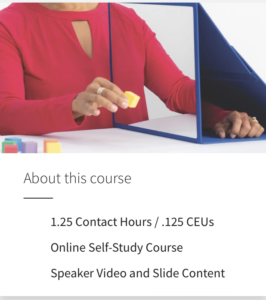
Register Now
6 Tips to Build Trust with Stroke Patients
NeuroRehab Team
Friday, March 3rd, 2023
Suffering from a neurological injury such as stroke can be a long and hard battle. Having the right team in place can make a significant impact on the success of one’s recovery. Being comfortable with one’s clinical team can set patients up for great success. Health professional building that immediate trust is key to a positive outcome.
Stroke Therapy Research. What works?
NeuroRehab Team
Friday, January 13th, 2023
Arm and HandElectrical StimulationHand Function SplintsMental PracticeMirror TherapyNeuroplasticityStroke Statistics

Every 2.1 seconds, someone in the world suffers a stroke. Stroke is the #1 cause of long-term disability worldwide. Globally, there are over 15 million stroke survivors. With respect to the United States, there are approximately 5.1 million stroke survivors alive today in the US. It is the third leading cause of death in USA and the numbers are expected to double by 2030.
How Long Should I Use Electrical Stimulation for My Stroke?
NeuroRehab Team
Monday, January 9th, 2023
Electrical Stimulation. How much is enough?
Over the years, many stroke survivors have stated that their therapist recommended 20-30 minutes of electrical stimulation to a targeted area for daily home use. Are we are missing an opportunity to maximize the therapeutic benefit of stimulation by limiting the total treatment time under 30 minutes?
Free Constraint-Induced Movement Therapy CEU Course for OT’s
NeuroRehab Team
Wednesday, December 28th, 2022
Course Title:
Constraint-Induced Movement Therapy. Understanding the Facts and Myths.
Overview:
This AOTA approved online self-study continuing education class will introduce you to evidence-based practice surrounding Constraint-Induced Movement Therapy to the stroke population.
The online class is intended for medical professionals (e.g. OT/OTA, PT/PTA, Physicians, etc.) directly related to the rehabilitation of a patient or client. To participate in this CEU and receive credit, the participant must be a licensed, treating clinician. Completion of this course will reward the participant with .1 CEUs or 1 contact hour, following completion of the presentation and a ≥80% score on the quiz. You will have 90 days to complete this course.
Free Online CEU Electrical Stimulation Course for OT’s
NeuroRehab Team
Monday, December 26th, 2022
Course Title:
Electrical Stimulation for Stroke Recovery. A review of evidence-based clinical considerations.
Overview:
This AOTA approved online self-study continuing education class will introduce you to evidence-based practice surrounding electrical stimulation to the stroke population.
The online class is intended for medical professionals (e.g. OT/OTA, PT/PTA, Physicians, etc.) directly related to the rehabilitation of a patient or client. To participate in this CEU and receive credit, the participant must be a licensed, treating clinician. Completion of this course will reward the participant with .1 CEUs or 1 contact hour, following completion of the presentation and a ≥80% score on the quiz. You will have 90 days to complete this course.
Stop Learned Non-Use to Improve Stroke Recovery
NeuroRehab Team
Wednesday, December 21st, 2022
If one asked 10 new stroke survivors the following question, what do you think they would say?
“Would you rather spend most of your time learning compensatory one-handed strategies with your unaffected side, or would you rather focus on improving strength, range of motion and function in your affected limb?” That’s a big question.
Stroke Shoulder Online CEU Course Now Available
NeuroRehab Team
Thursday, December 8th, 2022
Stroke Shoulder Simplified.
Demystifying subluxation, pain and stiffness.
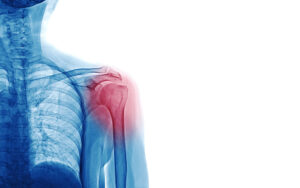
Robotic Therapy for Stroke. Is it Overrated?
NeuroRehab Team
Friday, December 2nd, 2022
Robot-assisted therapy has become increasingly popular over the last 2 decades. In fact, it is so well-known that out of the 1,300 RCT’s in UE stroke recovery, robotic research leads the pack with 112 RCT’s! There is no doubt robotic therapy, in some form or fashion, is here to stay, however is it a MUST-HAVE or a NICE-TO-HAVE intervention?
Online Shoulder Stroke/Neuro Occupational Therapy CEUs
NeuroRehab Team
Saturday, November 26th, 2022
Shoulder pain resulting from stroke hemiplegia is a common clinical consequence. Hemiplegic shoulder pain can occur as early as two weeks post-stroke but an onset of two to three months is more typical. Frozen shoulder, pain and weakness can negatively affect rehabilitation outcomes as good shoulder function is a prerequisite for successful transfers, maintaining balance, effective hand function, and performing ADL’s activities of daily living.
Should You Strengthen a Spastic Muscle?
NeuroRehab Team
Wednesday, November 23rd, 2022
Great question. The answer is ABSOLUTELY!
For some clinicians, strengthening a hyperactive or spastic muscle is a very controversial topic. The thought of having stroke survivors squeeze their spastic finger flexors or flex their overactive biceps causes some clinicians to cringe.
How to Select a Top OT Stroke CEU – Continuing Education Class
NeuroRehab Team
Saturday, November 19th, 2022

Stroke recovery is a hard and long journey for most patients. There are therapists that “treat neuro patients” and then there are “neuro therapists”. In order for a patient to reach maximum potential with their rehab journey, they will need a clinician that understands, appreciates and knows the neurorecovery process.
Stroke Plateaus are Not Permanent
NeuroRehab Team
Friday, November 18th, 2022
Hand Function SplintsNeuroplasticity
There is no expiration date on neuroplasticity.
Just like athletes and musicians, many stroke survivors will have periodic and temporary plateaus or setbacks as they continue to improve. It is a back-and-forth process. Improve a little, then a plateau occurs. Modify the training and improve some more. Then, here comes another plateau. Modify again. You get the idea.
Occupational Therapy – OT CEUs
NeuroRehab Team
Wednesday, November 16th, 2022
Occupational Therapy CEUs!
Occupational Therapy (OT) CEU’s are part of the necessary requirements to maintain one’s license. In addition, a clinician may seek out paid or free continuing education classes (CEU) to advance his or her knowledge and skill set.
Improve Results Following Stroke with These Simple Steps.
NeuroRehab Team
Monday, November 14th, 2022
Mental PracticeMirror TherapyNeuroplasticitypriming

Priming the Brain Works.
Better clinical outcomes following stroke are associated with interventions such as cortical priming resulting in increased excitability of the motor cortex (Catano et al).
Priming is a technique used to enhance the brain’s ability to re-balance the 2 hemispheres following a stroke. Priming interventions include invasive and non-invasive techniques and can be administered prior to or during therapy.
The Best Way to Treat Shoulder Subluxation
NeuroRehab Team
Friday, November 4th, 2022
Electrical Stimulationshouldersubluxation

The shoulder is the most complicated joint in the human body. It’s also one of the most difficult aspects of recovery for hemiplegic stroke survivors.
Why?
Be Like Mike. Mental Practice Improves Stroke Arm and Hand Weakness.
NeuroRehab Team
Friday, October 28th, 2022
Mental PracticeNeuroplasticity

Be Like Mike.
Before each race, Michael Phelps, the 28-time Olympic medalist, would sit quietly and perform mental reps, imagining his performance step-by-step.
Stroke Survivors Should Look in the Mirror – Daily.
NeuroRehab Team
Friday, October 14th, 2022
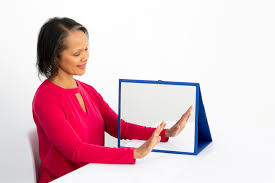
Stroke survivors are beautiful and handsome heroes. But it’s not about vanity – it’s about recovery. Mirror Therapy (MT) is a critical intervention – yet vastly underutilized.
Neuroplasticity Following Stroke: How the Brain Improves.
NeuroRehab Team
Friday, October 7th, 2022

The Brain is Fascinating!
The brain consists of 100 billion neurons and 200 trillion synapses. It’s nearly impossible to grasp the complexity and power of this amazing organ. During a stroke, 32,000 neurons die every SECOND, totaling around 1.2 billion for the entire event. That’s a lot, but consider the total neurons in the brain, it’s around 1%. That means 99% of the brain is still intact!
Prevent Falls After Stroke
NeuroRehab Team
Sunday, August 22nd, 2021

Falls can happen anytime and anywhere to people of any age. However, as people get older, or suffer neurological injuries such as stroke, the number of falls and the severity of injury resulting from falls increases. Taking precautions to prevent falling after stroke can help save a life. Falling is the leading cause of accidental home deaths, and they are a major reason for 40% of admissions to nursing homes.
Constraint-Induced Movement Therapy (CIMT) for Stroke Therapy
NeuroRehab Team
Saturday, June 26th, 2021
Constraint-Induced Movement Therapy (CIMT) is a form of treatment designed to decrease the impact of a stroke on the upper-limb (UL) function of some stroke survivors. It is a behavioral approach to neurorehabilitation[2] based on “Learned- Nonuse”.
Gondola Medical Foot Device Helps Patients with Walking and Balance Disorders
NeuroRehab Team
Wednesday, March 24th, 2021
Electrical StimulationLegNeuroplasticity
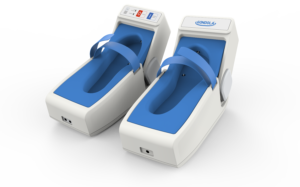
The Gondola Medical Device provides a non-invasive mechanical stimulation based on pressure pulses. The pulses are applied in two specific areas of both feet, the head of the big toe and the first metatarsal joint. The treatment comprises four cycles of stimulation; one cycle includes a six-second stimulation of each of the four target areas (total: 24 sec). The overall treatment consists of four repetitions of the stimulation cycle (total: 2 minutes). This method of treatment is called “Automated Mechanical Peripheral Stimulation” (AMPS).
UE Ranger Helps Improve Shoulder and Arm Strength
NeuroRehab Team
Thursday, March 11th, 2021
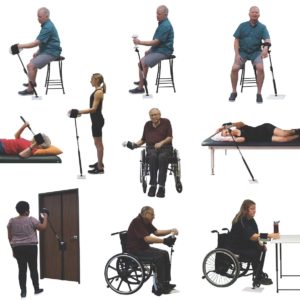
The UE Ranger was designed to help you exercise your arm not only in the clinic during your rehab sessions, but also at home. More rehab equals more recovery, so empowering yourself with the UE Ranger at home is a game changer.
The Xtern : A Game Changer for Foot Drop Patients
NeuroRehab Team
Tuesday, February 9th, 2021
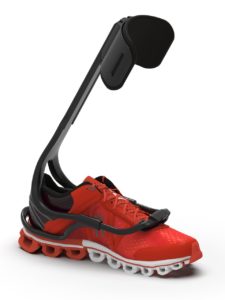
When François suffered multiple injuries from a snowmobile accident in 2001, he knew his life would change forever. After fracturing both legs and knees, he was left with a complete foot drop on one side. Over the years, he tried various ankle and foot orthosis (AFOs), but couldn’t find the one that would allow him to get his life back. That’s how Turbomed was born.
NIH Stroke Scale: What is it and how does it work?
NeuroRehab Team
Friday, January 22nd, 2021

National Institutes of Health Stroke Scale (NIHSS) is a clinical tool that measures stroke-related neurologic deficits. This measure can be quantified. NIHSS is used in modern neurology for three main objectives;
- to evaluate the violence of stroke to its patients and document the neurological status of the patients.
- To determine the treatment to be administered to patients by planning the appropriate patient care and act as a common language for the exchange of information understood by healthcare providers.
- To predict the outcome of the patient from the illness, both long and short term outcomes. It can also indicate a lesion size and be a measure of stroke severity.
Stroke Survival Statistics: Key Facts To Know
NeuroRehab Team
Wednesday, December 23rd, 2020
Stroke Statistics
Stroke is among the leading causes of severe long-term disabilities. It reduces mobility in more than 50% of its patients who are aged 65 and above. According to NINDS, 15-30% of patients develop a permanent physical disability while most patients regain their hands and legs’ functionality. Symptoms associated with stroke vary from dizziness, fatigue, blurred vision, slurred speech, fatigue, and numbness. However, according to a survey done, only 38% of the respondents knew the stroke’s significant symptoms. The most recognized sign by 98% of the respondents was numbness on one side. Knowing these symptoms is crucial because it can reduce disability in patients. Those who start receiving treatment three hours after the first symptom show less disability than those who receive delayed care.
Top Stroke Exercise for Arm Strength
NeuroRehab Team
Tuesday, December 15th, 2020

A stroke occurs when the blood vessels in your brain bleed due to a rupture. It can also happen when the blood supply to your brain is blocked. When blood supply is blocked, or blood vessels rupture, blood, and oxygen do not reach the brain tissues, and without oxygen, these cells and tissues become damaged and start dying within a short time.
Treat Shoulder Subluxation Safely With New Therapy Tool
NeuroRehab Team
Monday, December 7th, 2020

Despite many different style arm slings for stroke, current shoulder positioning devices don’t address the numerous frustrations patients and therapists describe when trying to effectively treat a subluxed shoulder that is the result of a brain injury or spinal cord injury. Common reasons reported why existing shoulder subluxation products are less than favorable and aren’t worn regularly include:
Cognitive Neuro Therapy Tool Helps Patients Improve Function and Independence
NeuroRehab Team
Wednesday, December 2nd, 2020

NeuronUP is a 3-in-1 tool to help the neurorehabilitation specialist save time in a clinical setting. The web based platform that offers professionals activities of daily living for the rehabilitation and cognitive stimulation of people with brain damage, neurodegenerative diseases (Alzheimer’s, MS, Parkinson’s), neurodevelopmental disorders (ADHD, ASD), mental and intellectual disabilities, deficits from normal aging, etc.
Must Read Stroke Recovery Book for Caregivers and Survivors
NeuroRehab Team
Wednesday, December 2nd, 2020
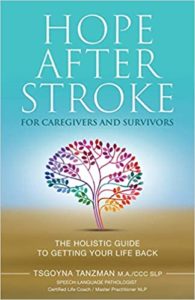
Readers are calling Hope After Stroke for Caregivers and Survivors: The Holistic Guide to Getting Your Life Back, the “The Stroke Bible,” that should be in every hospital and rehab facility. It’s a must read for every caregiver and survivor.
Grip Device Helps Patients with Poor Grip Strength Improve Independence
NeuroRehab Team
Wednesday, December 2nd, 2020
Adaptive EquipmentArm and HandGrip Aid
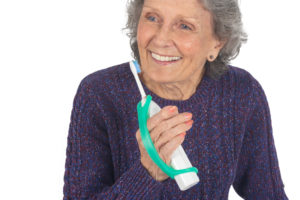
EazyHold is an innovative grip aid for children and adults who have limited grip abilities. The silicone universal cuffs adapt easily to hold eating utensils, grooming aids, crayons, sports, equip, musical instruments, and even toys! They gently hug the back of the hand and support the tool, relieving the need for grip and encouraging full arm movement. The one-piece soft silicone bands are easily washed, quick-drying, non-toxic, hypoallergenic, latex-free, and come in multiple sizes.
How Many Repetitions are Needed for Stroke Recovery?
Lynette Diaz, COTA/L
Tuesday, June 9th, 2020

How many repetitions does it take to create changes in the brain? How many repetitions must one complete before movement is strong, volitional and functional? Research indicates the number is high and the answer is more complex than we may think. Factors to be considered are, quality of repetitions, attention during repetitions, number of joints involved in movement, area of injury in the brain to name a few. It would stand to reason the more complex a movement is the more repetitions would be required.
Rewiring the Brain Through Gratitude
Lynette Diaz, COTA/L
Monday, June 8th, 2020

Attitude of Gratitude.
After experiencing a traumatic injury such as a stroke, it may be hard for many people to perceive daily things in a positive light. After all, life is not what it was before. Many stroke survivors go from an independent lifestyle to depending on a loved one. It is evident to see how there is not much room for positive thought.
What You Need to Know About the Stroke Recovery Timeline
NeuroRehab Team
Wednesday, February 19th, 2020
Arm and HandContracture SplintElectrical StimulationHand Function SplintsMental PracticeMirror TherapyNeuroplasticityStretchingSubluxation Slings

You are eager to return to your normal life, so you are ready to learn more about the typical timeline for recovery after a stroke. Keep reading to get some answers to common questions:
- Am I going to get better after my stroke?
- How long is rehab after a stroke going to take?
- What can I do to help my stroke recovery?
Walking and Stroke Recovery: What You Need to Know
NeuroRehab Team
Saturday, January 25th, 2020
Electrical StimulationFoot Drop BraceLegMobilityNeuroplasticity
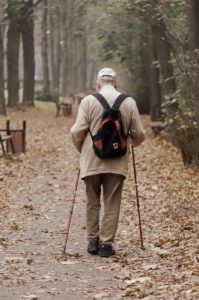
A stroke can impact any number of life skills. But the ability to walk can be one of the most significant. Many people identify walking as an important goal after they experience a stroke. This makes sense because walking is related to so many daily routines. Every stroke survivor is different. Some stroke survivors might need help to walk a few feet. Other individuals might recover significantly and be able to walk long distances. This article will provide post-stroke walking education for a range of skill levels.
Easy Hand Exercises to Boost Recovery from a Stroke
NeuroRehab Team
Tuesday, January 14th, 2020
Exercise AidsFine Motor CoordinationStrengthening

Launching a hand exercise program begins with understanding how a stroke that happens in your brain can cause problems with your hand. A stroke is basically an injury to the brain due to limited blood flow. The symptoms in the body reflect the area of injury in the brain. So a stroke survivor with hand issues, experienced an injury to the area of the brain that controls the hand.
Improving Sleep Apnea Helps With Stroke Recovery
NeuroRehab Team
Thursday, December 26th, 2019
Sleep Apnea is a known risk factor for stroke and new research suggests that curbing the condition might also aid the recovery of people who’ve suffered a stroke or mini-stroke. New research shows that, among stroke patients, “treatment of sleep apnea with CPAP therapy provides significant benefits, even greater than the benefits of tPA, the FDA-approved drug treatment for stroke,” said study lead researcher Dr. Dawn Bravata.
10 Must-Read Stroke Recovery Books
NeuroRehab Team
Wednesday, December 25th, 2019
When suffering from a brain injury such as stroke, a sense of hopelessness, frustration and vulnerability can occur. Don’t be alone on your journey to recovery! Below are excellent books that provide immense insight into stroke recovery. Click on any of the links for more information.
Adaptive Clothing Tips for Stroke Survivors
NeuroRehab Team
Monday, December 23rd, 2019
Getting oneself dressed is a critical part of being a fully independent person. For a person who has had a stroke, getting dressed can help feel more normal again. This can really help to boost both mood and self esteem.
The tips below will help both the stroke patient and the caregiver make dressing an easier part of the daily routine:
Are You Overstretching Your Spastic Muscles?
Lynette Diaz, COTA/L
Monday, December 23rd, 2019

Stretching can be a very important part of recovery especially following a stroke, when feeling, sensation and movement are returning to a previously flaccid limb. However, is it possible to stretch too much or too hard? Yes it is.
Clinicians frequently see patients handle their affected limbs rather aggressively in an effort to “make it move” or “get it loose”, often stretching their fingers, wrist, elbows and shoulders too far too fast. This may partly be due to lack of sensation or awareness.
Stroke Home Therapy Products Available on Amazon
NeuroRehab Team
Saturday, December 21st, 2019
Stroke survivors often struggle to regain full use of their affected side. Below are a just a few of the available products on Amazon that can help with improving more recovery at home. Whether you are hoping to improve your arm and hand strength or looking for better results with your walking and endurance, the good news is that you can find excellent products for very low prices. Just take a look below and click for more information.
8 Helpful Adaptive Stroke Equipment Ideas To Improve Independence
NeuroRehab Team
Thursday, December 19th, 2019
Adaptive equipment helps stroke patients experience greater independence with everyday life skills or activities of daily living. There is a plethora of assistive devices for all areas of self care including dressing, bathing, grooming, cooking, feeding, toileting, and mobility aids.
Improve Balance With These 5 Affordable Therapy Products
NeuroRehab Team
Tuesday, December 10th, 2019
Decreased balance is a common area affected by stroke. Many patients are prone to falling which could lead to serious injuries. Studies have shown that stroke survivors are twice as likely to fall following a stroke and more than three times as likely as the general population to fall multiple times. About 40 percent of stroke survivors have serious falls within a year of their stroke.
Virtual Rehabilitation Using Nintendo Wii and Conventional Physical Therapy Effectively Treat Post-Stroke Hemiparetic Patients.
NeuroRehab Team
Tuesday, December 3rd, 2019

Da Silva Ribeiro NM, Ferraz DD, Pedreira E, et.al. Topics in Stroke Rehabilitation 2015; 22: 299-305.
This study compared the use of the Wii Nintendo to a conventional physical therapy program to improve both sensorimotor activity (measured by the total Fugl-Meyer assessment score) and quality of life (measured using the SF-36). Thirty stroke survivors were randomly assigned to either group and all participants received two hourly sessions for each of two months.
Muscle Tone Following Stroke
Dorothee Zuleger, MOT, OTR/L, DRS
Thursday, November 21st, 2019

Following a stroke, abnormal muscle tone is a common complication. A single muscle or a muscle group may become completely paralyzed. This is known as hypotonic or flaccid or a muscle may increase in muscle tone. This is known as hypertonic or spastic. This abnormal tone usually occurs in the side of the body opposite to the side of the brain lesion.
Returning Home Following a Stroke: Helpful Tips for Modifying Your Kitchen.
NeuroRehab Team
Saturday, November 2nd, 2019

When a stroke patient returns home, the home environment can impact a person’s recovery. The home includes the social and cultural environment such as the people who live there, as well as the physical aspects of the home such as steps and layout. It is important that the home environment be one that supports continuing recovery and safety for the patient. This article is intended to provide basic information to stroke survivors and their families about potential problems with the physical aspects of the kitchen.
Top Ankle and Foot Stretching Products To Improve Flexibility Following Stroke
NeuroRehab Team
Friday, October 25th, 2019

Stroke can cause muscle weakness and tightness along one side of the body. Muscle weakness affects how well you move your body. Without continuous movement daily, your muscles, joints and ligaments will become gradually stiff eventually leading to a contracture.
Search Contracture Foot and Ankle Splints
The ankle and foot is one of the common areas affected by stroke. Often times, foot drop occurs which causes the foot not to clear and lift when walking, which could lead to a risk of falls. When suffering from foot drop, you may experience ankle stiffness over time.
Effectiveness of Functional Electrical Stimulation on Wrist and Finger Flexor Spasticity in Hemiplegia.
NeuroRehab Team
Thursday, October 17th, 2019

Yuzer GFN, Dönmez, Özgirgin N. J Stroke Cerebrovasc Dis 2017 (in press).
This randomized trial investigated the effects of functional electrical stimulation of the wrist and finger extensor muscles of patients with chronic stroke who had spasticity of their wrist flexors. The electrical stimulation intervention was applied for 30 minutes a day for 5 days a week for a total of 20 sessions to fully extend the wrist and finger flexors.

